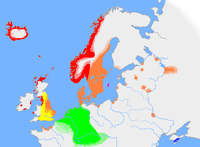
Back Oldøstnordisk Danish Altostnordisch German Oudoostnoords Dutch Nórdico antigo oriental Portuguese Old East Norse SIMPLE Fornöstnordiska Swedish
This article has multiple issues. Please help improve it or discuss these issues on the talk page. (Learn how and when to remove these messages)
|
| Old East Norse | |
|---|---|
| Øst Norrönt / Östr Norrœnt (West Norse), Øst-Skandinavisk (East Scandinavian) | |
 | |
| Region | Denmark, Sweden, England, Normandy, the Volga and places in-between |
| Era | 9th-12th century |
Indo-European
| |
Early forms | |
| Runic, later Latin | |
| Language codes | |
| ISO 639-3 | None (mis) |
| Glottolog | None |
| Part of a series on |
| Old Norse |
|---|
 |
| WikiProject Norse history and culture |
Old East Norse was a dialect of Old Norse which evolved into the languages of Old Danish and Old Swedish from the 9th century to the 12th century.
Between 800 and 1100, East Norse is in Sweden called Runic Swedish and in Denmark Runic Danish. The use of Swedish and Danish is not for linguistic reasons as the differences between them are minute at best during the more ancient stages of this dialect group. Changes had a tendency to occur earlier in the Danish region and until this day many Old Danish changes have still not taken place in modern Swedish rendering Swedish as the more archaic out of the two concerning both the ancient and the modern languages, sometimes by a profound margin but in all differences are still minute. They are called runic because the body of text appears in runes.
Runic Old East Norse is characteristically archaic in form, especially Swedish (which is still true for modern Swedish compared to Danish). In essence it matches or surpasses the archaicness of post-runic Old West Norse which in its turn is generally more archaic than post-runic Old East Norse. While typically "Eastern" in structure, many later post-runic changes and trademarks of EON had yet to happen.